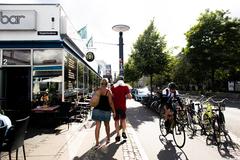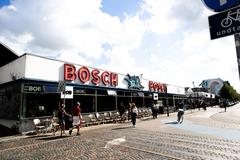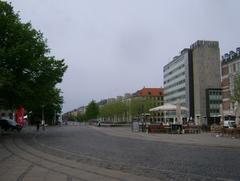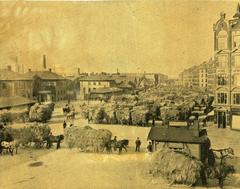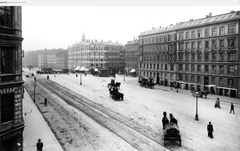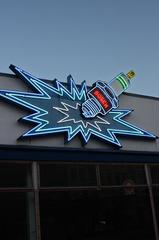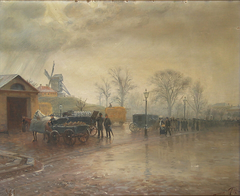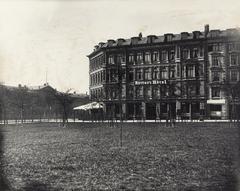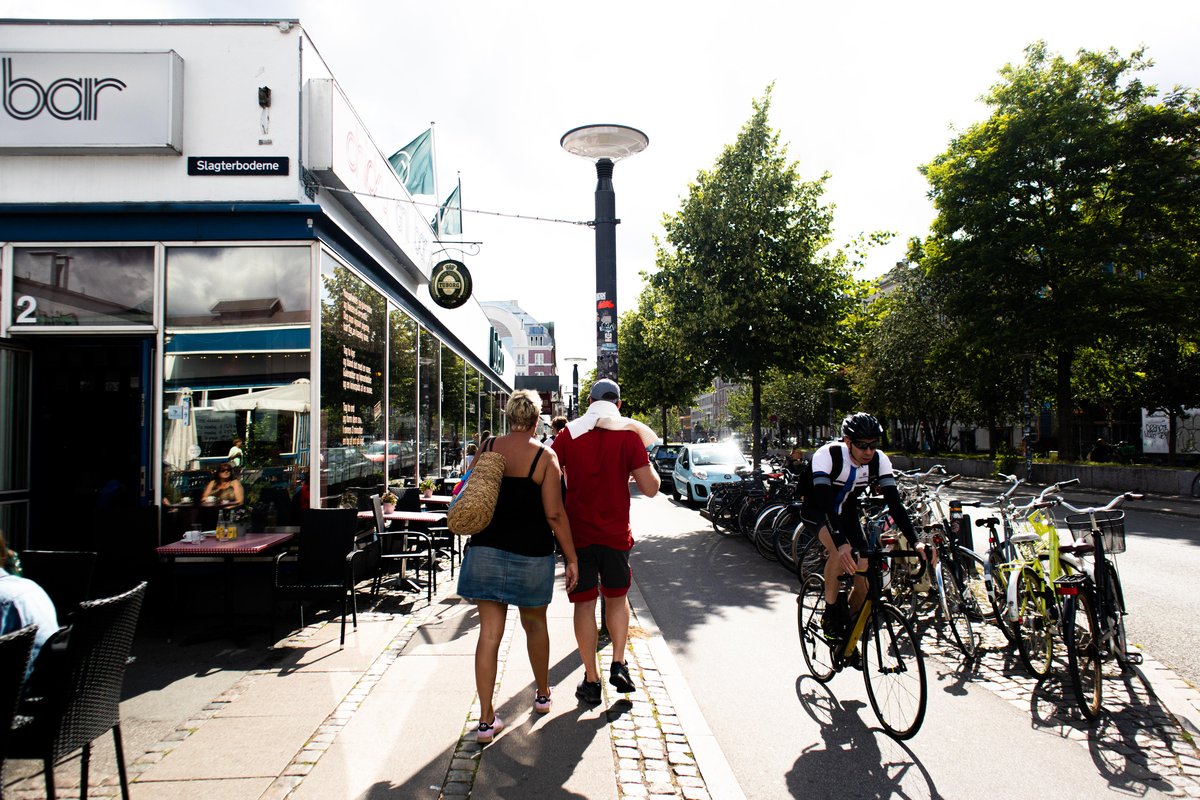
Halmtorvet Copenhagen: Visiting Hours, Tickets, and Historical Sites Guide
Date: 15/06/2025
Introduction
Nestled in Copenhagen’s lively Vesterbro district, Halmtorvet is a public square that beautifully blends the city’s rich historical legacy with its dynamic present-day culture. Once the city’s central hay and straw market, Halmtorvet has evolved into a vibrant urban hub, renowned for its inclusive design, cultural venues, and year-round events. This comprehensive guide explores Halmtorvet’s history, visiting tips, architectural highlights, and practical information, ensuring an enriching experience for every visitor.
Table of Contents
- Introduction to Halmtorvet: History & Significance
- Historical Overview
- Visitor Information
- Halmtorvet’s Role in Urban & Social Fabric
- Exploring Halmtorvet: Events, Activities, and Dining
- Visitor Tips & Frequently Asked Questions
- Summary & Final Recommendations
- References
Halmtorvet: A Historic Hay Market Transformed
Halmtorvet, meaning “Hay Market,” is central to Vesterbro’s identity. Established in the 19th century, it was originally located near the city’s West Gate (Vesterport) at what is now Rådhuspladsen. This bustling market supported Copenhagen’s livestock and horse-drawn transport economy, with traveling salesmen trading hay and straw in a city dependent on animal-powered commerce (Historic Hotels; Rundt i Danmark; Danish Design Review).
With the removal of city fortifications and rapid urban expansion in the late 19th century, the market was relocated in 1888 to its current site in Vesterbro, adjacent to the new Central Railway Station and the burgeoning Meatpacking District (Kødbyen). This shift mirrored Copenhagen’s industrialization and urban transformation, cementing Halmtorvet’s role in supporting the city’s meat and agricultural industries (Rundt i Danmark; Danish Design Review).
The area’s architecture, including landmarks such as Øksnehallen (1901) and the White Meat Market, reflects this commercial history. However, as motor vehicles replaced horses, the square’s traditional role diminished, leading to a period of urban decline in the 20th century (Lokalhistorisk). By the late 1990s, Halmtorvet and Vesterbro had faced significant social challenges, but city-led regeneration efforts began revitalizing the square, creating the lively, inclusive space seen today (Rundt i Danmark).
Visiting Halmtorvet: Hours, Tickets, and Accessibility
Visiting Hours: Halmtorvet is open 24/7 year-round. There are no gates or restrictions, and the square is always accessible.
Tickets & Entry: The square is free to visit at any time. Some special events or nearby venues, such as exhibitions at Øksnehallen, may charge separate admission fees.
Getting There:
- Train: Just steps from Copenhagen Central Station (København H).
- Bus: Multiple routes stop nearby.
- Bicycle: The city’s extensive bike lanes and plentiful bike racks make cycling the easiest way to arrive.
Accessibility: Halmtorvet features level, wide pathways, accessible seating, and nearby accessible public transport. Public restrooms are located at adjacent facilities.
Guided Tours: Guided walking tours of Vesterbro and Copenhagen’s historic sites often include Halmtorvet. Check local tour providers or tourism websites for schedules.
Key Attractions and Events
Nearby Attractions:
- Copenhagen Central Station: Major transport hub and architectural landmark.
- Meatpacking District (Kødbyen): Trendy restaurants, bars, galleries, and nightlife.
- Sønder Boulevard: Urban park ideal for relaxation.
- Øksnehallen: Former cattle hall now hosting art exhibitions and public events.
- Tivoli Gardens: Historic amusement park within walking distance.
- Strøget: Copenhagen’s main pedestrian shopping street.
Special Events & Photo Spots:
- Markets, food festivals, outdoor concerts, art installations, and community gatherings happen throughout the year. The square’s mix of historic and modern architecture provides a rich backdrop for photography, especially near Øksnehallen and the Meatpacking District (Danish Design Review; Evendo).
Halmtorvet’s Urban and Social Fabric
Halmtorvet stands as a model of Copenhagen’s “liveable city” ethos, where economic vitality, social inclusion, and environmental sustainability converge (Field Actions Science Reports). The square’s design—with open lawns, mature trees, flexible seating, and playgrounds—encourages spontaneous gatherings, family activities, and community events. Its proximity to the Meatpacking District amplifies its role as a social and cultural hub (Wikipedia).
Cultural venues such as Øksnehallen and Husets Teater contribute to a dynamic arts scene, while projects like Art Hub Copenhagen further underscore Halmtorvet’s role in fostering artistic innovation (Art Hub Copenhagen). The square’s inclusive design helps reduce social segregation, attracting a diverse mix of residents, families, and international visitors (Field Actions Science Reports).
Nightlife: Halmtorvet is a focal point for Copenhagen’s nightlife, with venues like Halmtorvet 9 and a range of bars and clubs in the adjacent Meatpacking District attracting visitors late into the night (Clubbable).
Urban Design, Architecture, and Environmental Features
Halmtorvet’s architectural character blends historic Danish brickwork and robust masonry from the late 19th century with contemporary glass-fronted cafés and minimalist urban furniture. The adaptive reuse of former warehouses and stables for cafés, restaurants, and creative spaces demonstrates Copenhagen’s commitment to preserving heritage while embracing modernity (Evendo).
Landscape and Sustainability:
- Mature trees and seasonal flower beds provide shade and environmental benefits.
- Benches, lawns, and playgrounds support relaxation and play.
- Recent infrastructure upgrades, such as improved drainage, enhance climate resilience (Danish Design Review).
Community Activation:
- Regular markets, exhibitions, and street performances foster a lively atmosphere.
- Initiatives like HALMTORVET V exemplify participatory design, offering urban gardens, communal tables, and sports courts co-created by residents (Leth & Gori).
Exploring Halmtorvet: Food, Activities, and Tips
Dining:
- The square and surrounding area feature cafés, bakeries, and casual eateries, often with outdoor seating.
- The Meatpacking District offers an array of restaurants and bars, from traditional Danish cuisine to international street food.
Activities:
- Attend open-air concerts, flea markets, and seasonal festivals.
- Explore nearby cultural venues and art exhibitions.
- Enjoy the playgrounds and green spaces with family.
Practical Tips:
- Best Time to Visit: Late spring to early autumn for pleasant weather and vibrant events.
- Family-Friendly: Playgrounds and open lawns make it ideal for children.
- Getting Around: Walking and biking are the best ways to explore Vesterbro and its attractions.
- Safety: The area is generally safe; exercise standard precautions during busy events.
Frequently Asked Questions (FAQ)
Q: Is there an entrance fee to Halmtorvet?
A: No, Halmtorvet is a public square and free to visit.
Q: What are the visiting hours?
A: The square is open 24 hours a day, every day, year-round.
Q: How do I get to Halmtorvet from Copenhagen Central Station?
A: It’s a 5–10 minute walk west from the station.
Q: Are there guided tours available?
A: Many walking tours of Vesterbro and Copenhagen include Halmtorvet.
Q: Is the area accessible for people with disabilities?
A: Yes, the square has smooth, wide pathways and accessible facilities.
Q: What events take place at Halmtorvet?
A: Markets, performances, exhibitions, and festivals happen throughout the year. Check local listings for schedules.
Summary and Final Recommendations
Halmtorvet is emblematic of Copenhagen’s successful urban renewal—a space where history, culture, and community converge. Its transformation from a 19th-century hay market to a lively, accessible public square highlights the city’s commitment to sustainable, people-centered design (Field Actions Science Reports; Leth & Gori).
Visitors can enjoy Halmtorvet’s vibrant atmosphere, explore its historical architecture, participate in community events, and discover nearby attractions like the Meatpacking District and Tivoli Gardens (Evendo). The square is an essential stop for anyone seeking to experience the authentic spirit of Copenhagen.
For current event updates and insider tips, download the Audiala app and consult local tourism resources (Official Copenhagen Tourism Site; LETH & GORI).
References
- Historic Hotels
- Rundt i Danmark
- Danish Design Review
- Lokalhistorisk
- Wikipedia
- Field Actions Science Reports
- Leth & Gori
- Art Hub Copenhagen
- Clubbable
- Evendo
- Official Copenhagen Tourism Site
